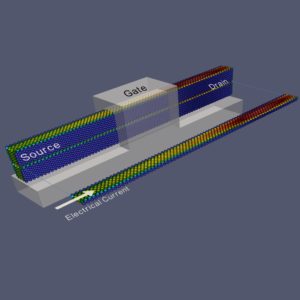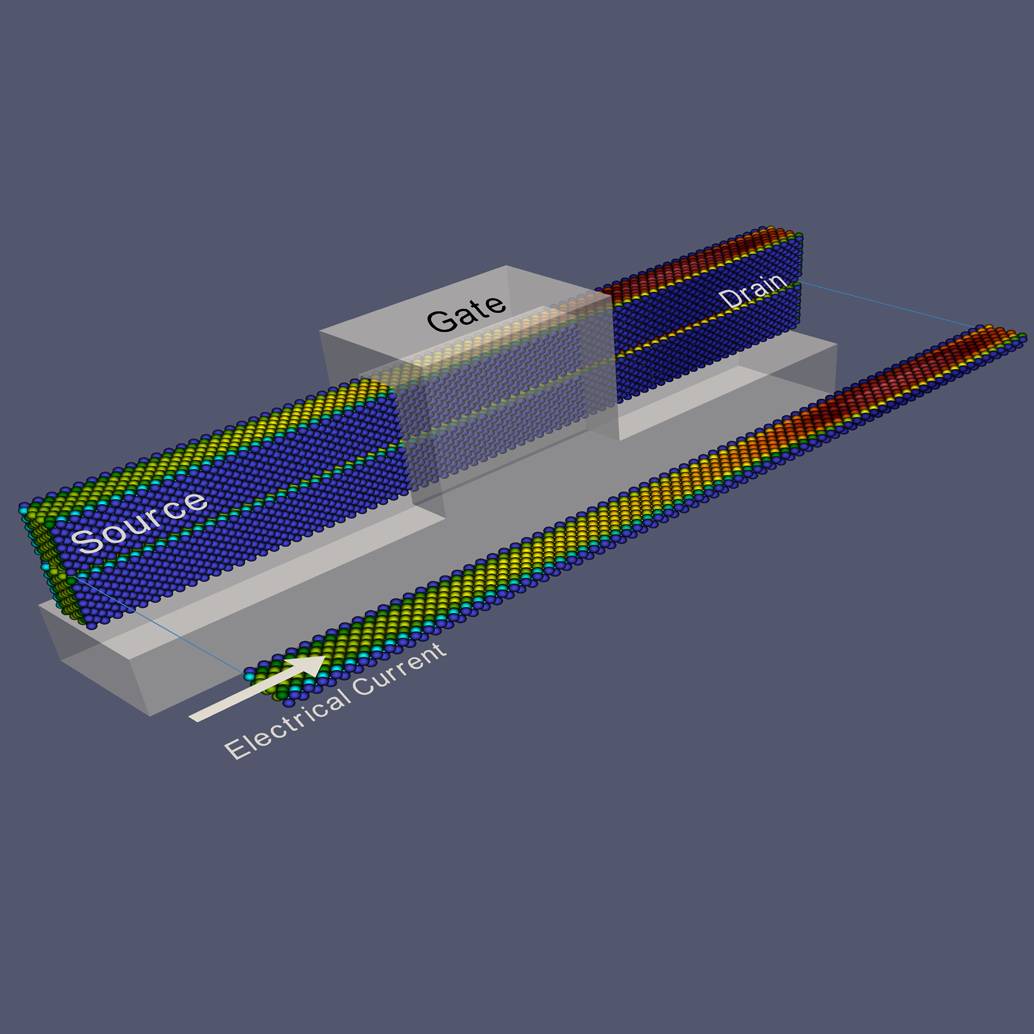In this special guest feature, Simone Ulmer from CSCS writes that researchers writes that researchers from ETH Zurich have developed a method that can simulate nanoelectronics devices and their properties realistically, quickly and efficiently. This offers a ray of hope for the industry and data centre operators alike, both of which are struggling with the (over)heating that comes with increasingly small and powerful transistors – and with the high resulting electricity costs for cooling.

Self-heating in a so-called Fin field-effect transistor (FinFET) at high current densities. Each constituting Silicon atom is colored according to its temperature (Image: Jean Favre, CSCS)
Chip manufacturers are already assembling transistors that measure just a few nanometres across. They are much smaller than a human hair, whose diameter is approximately 20,000 nanometres in the case of finer strands. Now, demand for increasingly powerful supercomputers is driving the industry to develop components that are even smaller and yet more powerful at the same time.
One of the 2019 Gordon Bell Prize Finalists
However, in addition to physical laws that make it harder to build ultra-scaled transistors, the problem of the ever increasing heat dissipation is putting manufacturers in a tricky situation – partly due to steep rises in cooling requirements and the resulting demand for energy. Cooling the computers already accounts for up to 40 percent of power consumption in some data centres, as the research groups led by ETH professors Torsten Hoefler and Mathieu Luisier report in their latest study, which they hope will allow a better approach to be developed. With their study, the researchers are now nominated for the ACM Gordon Bell Prize, the most prestigious prize in the area of supercomputers, which is awarded annually at the SC supercomputing conference in the United States.
To make today’s nanotransistors more efficient, the research group led by Luisier from the Integrated Systems Laboratory (IIS) at ETH Zurich simulates transistors using software named OMEN, which is a so-called quantum transport simulator. OMEN runs its calculations based on what is known as density functional theory (DFT), allowing a realistic simulation of transistors in atomic resolution and at the quantum mechanical level. This simulation visualises how electrical current flows through the nanotransistor and how the electrons interact with crystal vibrations, thus enabling researchers to precisely identify locations where heat is produced. In turn, OMEN also provides useful clues as to where there is room for improvement.
Improving transistors using optimised simulations
Until now, conventional programming methods and supercomputers only permitted researchers to simulate heat dissipation in transistors consisting of around 1,000 atoms, as data communication between the processors and memory requirements made it impossible to produce a realistic simulation of larger objects. Most computer programs do not spend most of their time performing computing operations, but rather moving data between processors, main memory and external interfaces. According to the scientists, OMEN also suffered from a pronounced bottleneck in communication, which curtailed performance. “The software is already used in the semiconductor industry, but there is considerable room for improvement in terms of its numerical algorithms and parallelisation,” says Luisier.
Until now, the parallelization of OMEN was designed according to the physics of the electro-thermal problem, as Luisier explains. Now, Ph.D. student Alexandros Ziogas and the postdoc Tal Ben-Nun – working under Hoefler, head of the Scalable Parallel Computing Laboratory at ETH Zurich – have not looked at the physics but rather at the dependencies between the data. They reorganised the computing operations according to these dependencies, effectively without considering the underlying physics. In optimising the code, they had the help of two of the most powerful supercomputers in the world – “Piz Daint” at the Swiss National Supercomputing Centre (CSCS) and “Summit” at Oak Ridge National Laboratory in the US, the latter being the fastest supercomputer in the world. According to the researchers, the resulting code – dubbed DaCe OMEN – produced simulation results that were just as precise as those from the original OMEN software.
For the first time, DaCe OMEN has reportedly made it possible for researchers to produce a realistic simulation of transistors ten times the size, made up of 10,000 atoms, on the same number of processors – and up to 14 times faster than the original method took for 1,000 atoms. Overall, DaCe OMEN is more efficient than OMEN by two orders of magnitude: on Summit, it was possible to simulate, among other things, a realistic transistor up to 140 times faster with a sustained performance of 85.45 petaflops per second – and indeed to do so in double precision on 4,560 computer nodes. This extreme boost in computing speed has earned the researchers a nomination for the Gordon Bell Prize.
Data-centric programming
The scientists achieved this optimisation by applying the principles of data-centric parallel programming (DAPP), which was developed by Hoefler’s research group. Here, the aim is to minimise data transport and therefore communication between the processors. “This type of programming allows us to very accurately determine not only where this communication can be improved on various levels of the program, but also how we can tune specific computing-intensive sections, known as computational kernels, within the calculation for a single state,” says Ben-Nun. This multilevel approach makes it possible to optimise an application without having to rewrite it every time. Data movements are also optimised without modifying the original calculation – and for any desired computer architecture. “When we optimise the code for the target architecture, we’re now only changing it from the perspective of the performance engineer, and not that of the programmer – that is, the researcher who translates the scientific problem into code,” says Hoefler. This, he says, leads to the establishment of a very simple interface between computer scientists and interdisciplinary programmers.
The application of DaCe OMEN has shown that the most heat is generated near the end of the nanotransistor channel and revealed how it spreads from there and affects the whole system. The scientists are convinced that the new process for simulating electronic components of this kind has a variety of potential applications. One example is in the production of lithium batteries, which can lead to some unpleasant surprises when they overheat.
Data-centric programming is an approach that ETH Professor Torsten Hoefler has been pursuing for a number of years with a goal of putting the power of supercomputers to more efficient use. In 2015, Hoefler received an ERC Starting Grant for his project, Data Centric Parallel Programming (DAPP).
Source: CSCS
Reference: Ziogas AN, Ben-Nun T, FernándezGI, Schneider T, Luisier M & Hoefler T: A Data-Centric Approach to Extreme-Scale Ab initio Dissipative Quantum Transport Simulations, Proceedings of the International Conference for High Performance Computing, Networking, Storage and Analysis (SC19), November 2019.




